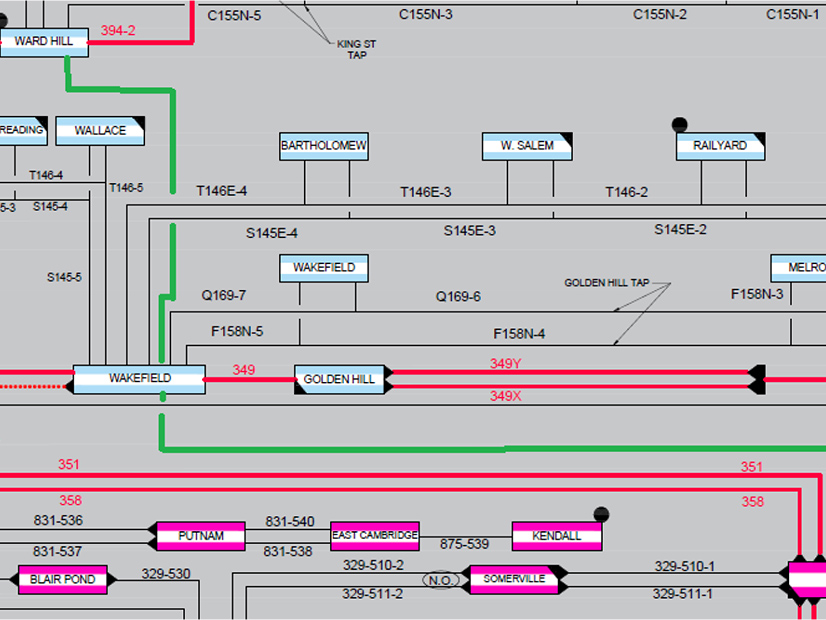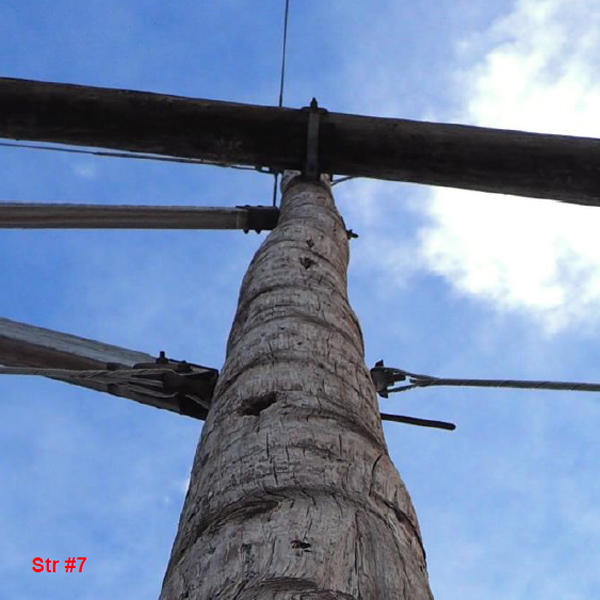
ISO-NE is studying line upgrades and new 345-kV and HVDC lines to address expected reliability violations in its 2050 Transmission Study.
Associate engineer Reid Collins briefed the Planning Advisory Committee April 20 on potential solutions for transmission overloads in Vermont and on north-south lines leading to Boston.
The 2050 Transmission Study, which resulted from a recommendation from the New England States Committee on Electricity’s October 2020 “New England States’ Vision for a Clean, Affordable, and Reliable 21st Century Regional Electric Grid,” will identify transmission needs required to satisfy NERC, Northeast Power Coordinating Council and ISO-NE reliability criteria in 2035, 2040 and 2050. (See States Demand ‘Central Role’ in ISO-NE Market Design.)
The RTO presented an initial round of proposed solutions in Boston and southwest Connecticut in December 2022.
Planners are primarily seeking solutions for scenarios that include a 2050 winter peak load of 51 GW. Some parts of those fixes also are expected to address needs in 2035 and 2040. The RTO is also considering additional solutions for a “high winter” 2050 peak of 57 GW.
Vermont Solutions
Planners are looking at three potential solutions for overloads resulting from large power transfers towards the Burlington area in northwestern Vermont.
Although many of the overloads can be resolved by rebuilding overhead lines, several underground or underwater sections would be very costly or difficult to rebuild, such as the PV-20 115-kV line running under Lake Champlain to Plattsburgh, New York, which cannot be fixed with the equipment that currently controls its flows.
The potential solutions are:
- Upgrade the PV-20 line from New York from 115 kV to 230 kV and build a new 115-kV line parallel to line K43. The underground and underwater segments of PV-20 are already built for 230 kV; only overhead segments would need to be upgraded. Collins said this would likely be the cheapest solution — involving the fewest miles — and could improve NYISO-ISO-NE transfer capability, reducing resource curtailments in northern New York. But it would be complicated by requiring construction in New York.
- Build a new 345-kV line from Coolidge to Essex, which would limit construction to New England and avoid many overhead rebuilds and the most difficult underground rebuilds. However, it would involve significantly more new construction than other solutions, at a higher cost, even though much of the new transmission could follow existing rights-of-way.
- Build a new 345-kV line from New Haven to Essex and a new 230-kV line from Granite to Essex. It would avoid many overhead rebuilds and most underground rebuilds and be limited to New England while requiring less new transmission construction than the Coolidge-Essex solution. But it would require the addition of two new transformers, rather than one, at Essex. It also would limit the use of the Granite 115-kV PARs to control flow on the existing 230-kV lines in Vermont and New Hampshire.
North-South Solutions
Many of the major lines running from Maine and New Hampshire into Massachusetts face overloads from excess generation in the north and large loads in southern New England.
In the primary solution set, and in the 2035 and 2040 solution subset, all the overloads can be fixed with rebuilds. In the 57 GW scenario, many of the overloads would be too severe to be addressed by rebuilding.
The potential solutions include:
- Re-route lines 375 and 3038 to avoid Surowiec and go straight from Maine Yankee to Buxton with a new 345-kV line for Surowiec-Timber Swamp-Ward Hill. A second 345-kV line for Timber Swamp-Ward Hill might be needed to fix the high winter scenario. In addition to reducing the need for rebuilds on existing lines, the new 345-kV line across major interfaces should improve voltage and stability performance. However, right-of-way (ROW) for some segments of the project would be cramped, and it would result in increased reliance on a single 345-kV ROW for moving power north to south.
- Add an HVDC line between the Surowiec 345-kV line and the Mystic 345-kV line. The solution also requires re-routing of lines 375 and 3038 to form a new Maine Yankee-Buxton 345-kV AC line. It would resolve many of the north-south transfer and Boston import issues while avoiding increased reliance on a single 345-kV ROW. This solution, combined with several 345-kV line rebuilds would solve north-south overloads as well as most Boston overloads in the primary solution set as well as the 2035 and 2040 solution subset. But additional solutions — possibly multiple point-to-point or offshore network HVDC lines — will be needed to meet the high winter peak for 2050.
- HVDC lines between Orrington or Surowiec, Maine, and Ludlow or Manchester, Vermont also are being tested to address north-south and east-west constraints in the high winter scenario. Although it would fix “significant numbers” of north-south overloads, it would not solve the Boston import issues, and the lengthy line could be expensive and difficult to site.
Boston Import Solutions
Boston is expected to experience import constraints during high flows into the area under both summer and winter peaks. Each season and each year studied found underground violations in at least some scenarios.
Planners project more overloads for the 2040 winter peak than for 2050 because the growth in wind injections into Boston will outpace the increased load.
Among the options being considered are:
- Building an HVDC line from Ward Hill to Mystic, which would significantly reduce the number of overloaded underground elements in Boston without needing to upgrade them directly. It would avoid possible short-circuit impacts of new 345-kV AC lines. But it could be “quite expensive,” the ISO said, and finding space for HVDC converter stations near Ward Hill and Mystic could be difficult.
- Adding a 345-kV AC line from Ward Hill-Wakefield Junction-Mystic could be cheaper than the HVDC option but it would be less effective at solving underground overloads in Boston.
To fix overloads on lines serving Boston from the south, planners are considering adding series reactors on the two existing Stoughton-K Street cables or adding a third Stoughton-K Street line, which would be more effective but also more expensive.
HVDC Line Configurations
The 2050 Transmission Study also is considering multiple options for HVDC lines, some with a point-to-point configuration (e.g., Surowiec-Mystic). “Others are implied through wind injections modeled as large generators at transmission-level buses,” the RTO said. Although the study is considering the lines individually, “it is also possible that these lines could be connected together to form an offshore grid,” the RTO added.
ISO-NE has hired Electrical Consultants Inc. to develop detailed cost estimates for some of the complex solutions. The RTO told ECI to avoid creating double-circuit towers, especially on the 345-kV network. The RTO also requested undergrounding lines as needed to avoid using eminent domain or displacing residents. It hopes to ease siting by placing new overhead lines along existing highway and railroad corridors.
“Detailed cost estimates will help to inform the region on both the costs and physical impacts of the projects examined,” the RTO said.
Next Steps
The RTO asked for feedback on the 2050 study presentation by May 5, with submissions to pacmatters@iso-ne.com.
Solution development work will continue through the end of this year in parallel with ECI’s cost estimates. The RTO’s next presentation will be in late summer or early fall, and a draft 2050 Transmission Study report is scheduled for release in November.
Asset Condition Projects
Also at the PAC meeting, National Grid (NYSE:NGG), Eversource Energy (NYSE:ES) and Vermont Electric Power Co. (VELCO) outlined plans to spend a combined $169 million on transmission line refurbishments:
 National Grid plans to spend an estimated $138 million to replace 178 wood structures with new steel structures on its 115-kV transmission line between the Harriman #8 substation in Readsboro, Vt. and the Adams #21 substation in Adams, Mass., including this damaged wood utility pole. | National Grid
National Grid plans to spend an estimated $138 million to replace 178 wood structures with new steel structures on its 115-kV transmission line between the Harriman #8 substation in Readsboro, Vt. and the Adams #21 substation in Adams, Mass., including this damaged wood utility pole. | National Grid- National Grid estimates it will spend $138.3 million on its 12-mile E-131 115-kV line between the Harriman #8 substation in Readsboro, Vermont, and the Adams #21 substation in Adams, Massachusetts, in an area with steep terrain. Constructed in 1925 and updated in 1971, it includes 209 structures, including a tap to the Bear Swamp substation. The company will install new steel structures to replace three lattice towers and almost 200 wood structures that showed signs of top splitting and woodpecker damage. The project, which will also include access road improvements, has an estimated in-service date in the third quarter of 2027.
- Eversource will replace wood structures with light-duty steel poles on a 5.4-mile section of 115-kV lines 1132 and 1505 on a shared right-of-way between Canterbury Switchyard and Killingly Station and the Brooklyn Tap in Connecticut. “If you replace [some structures] with wood, the woodpeckers will just find the next piece of wood out there,” said Eversource’s Chris Soderman. The estimated cost is $13.4 million, and the proposed in-service date is the first quarter of 2024.
- VELCO will replace 105 of 245 wood H-frame structures, most with steel H-frames, on its K43 115-kV line from Williston to New Haven. The 21-mile line was built in 1954 and originally operated at 69 kV. The cost is estimated at $16.9 million, and the company is targeting a 2026 completion.

